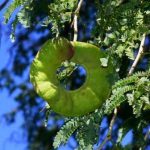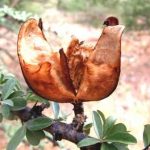TREE LIFE
May 1997
ANNUAL SUBS – NOW DUE
Happily it has not been necessary to increase our subs this year. Please send in your $40 promptly.
MASHONALAND CALENDAR
Tuesday 6th May: Botanic Garden Walk. We will meet Tom in the car park at 4.45 for 5 p.m. This month Tom will show us some of the palms and cycads in the Gardens. There will be a guard for the cars.
Sunday 18th May: Ken and Sue Worsley have kindly offered their garden for the A.G.M. Close to town off the Alpes Road in Teviotdale, on Mhowani Hills Farm set in lovely bush for our walk after the meeting. Please bring a chair and a contribution of a cake or other snack for tea at 9.15 a.m. The meeting will start promptly at 10.00 am.
Saturday 31st May: Mark’s Botanic Walk. An interesting time of year at Lyndhurst Farm.
Saturday 7th June: Botanic Garden Walk. 10.45 for 11 a.m. Please note the change of day and time during the three winter months.
MATABELELAND CALENDAR
Sunday 4th May: Trip to Tendele River, South Matopos. Please meet at the car park at Girls’ College for departure at 8.30 a.m.
Monday 12th May: Study Session. Urban trails in Circular Drive area. Meeting at 5-5.15 p.m. These sessions will take place on the second Monday of every month.
Wednesday 21st May: The A.G.M. of the Matabeleland Branch of the Tree Society will take place at Girls’ College at 7.30 for 8.00 p.m. Would those attending please come with any suggestions, comments or criticisms which they may have and would like to voice.
Sunday 1st June: To How Mine area to look at Olea europaea subsp. africana.
CHAIRMAN’S REPORT 1996-1997
The past year has rushed by filled with the many interesting and varied happenings that have made up the Tree Society calendar over the past year. Of particular importance was the Botanical Conference (abbreviated to AETFAT) in which some of our members were involved and had their botanical resolve tested in the incredibly wet Eastern Districts during early February.
It is gratifying to note that considering how busy life has become (perhaps it’s just me living in a disorganised state), the number of members who come out regularly on the outings remains fairly constant.
Once again my most grateful thanks to our dedicated members who give of their time and expertise in our monthly activities. Firstly thanks to Tom Muller for the Botanic Garden walks and for the helpful and humorous information that goes with it. After so many years of joking about rain cancelling the walks, Tom couldn’t believe his luck when rain stopped play for both the January and February sessions. Secondly to Mark Hyde for the time and effort involved with his Saturday afternoon Botanic interest walks and to Phil Haxen who once again is leading the main Sunday walks. The Society’s greatest asset is Maureen who as the editor, secretary and tree mapper does such a fantastic job, thank you so much Maureen. Our hosts are always willing to help, whether it be showing us a prize spot of countryside or a welcome cup of tea, my grateful thanks to you all. Wherever we go there are always some plants that defy identification and thanks to Bob Drummond for naming them for us.
With regard to our members, I am delighted to record and offer congratulations to Meg Coates Palgrave on being chosen Conservationist of the Year and receiving the Bob Rutherford Memorial Award and to Leslee Maasdorp for her outstanding work at Rifa, with the Cresta Conservation Award.
On a sadder note, it was with sorrow that we learned of the passing of Alan Pearce, a former Trustee of the Society, on the 20 July 1996 in Marondera.
Highlights of the year’s outings during the last year included, for Bulawayo, a trip to Malilangwe to see Erythrophysa, Shoshani Dam and a trip to the Raubs at Gwaai. For Harare, some relic forest patches near Ngomakurira, a Dyke outing with a difference looking at the geology and another attempt to find undamaged Bivinia in the Nyoni Hills and also the Oreobambos (the Buchwa Bamboo) over the August holidays, Umboe district with its superb Khaya anthotheca and in place of Mark’s walks during the dry months, The Private Life of Plants was screened, this being absolutely fascinating and it’s easy to see why Bulawayo enthused about it. A bit of luck for the Christmas social was by courtesy of Sue and Nick Fawcett. Manzou Game Lodge at Mazowe was ours for the day, the tree sanctuary proving to be a wonderful venue for the ever popular Tree Bingo.
Although the number of ‘finds’ on our outings is less than last year, spotting Felicia filifolia by Maureen near Fort Rixon is worth noting.
For those who are beginning to wonder, our Botanic Garden Fencing Fund overtook its target of $3000 and is being invested pending the finalization of the Botanic Garden fence project. Once again thanks to all who contributed.
A milestone was achieved as the 200th issue of Tree Life was published in October 1996. To have a publication ready with such a wide and interesting variety of topics requires considerable effort and my thanks to Maureen for the onerous task every month. I would like to express my appreciation to our regular contributors who include Mark Hyde with Botanic Garden reports and much more, Lyn Mullin with facts botanical and of tremendous interest to all, Mary Toet with the entomologist’s eye providing a different approach with fascinating information on butterflies and Cicada’s and Douglas Ball who writes on the medicinal/toxic values of plants. Without their support Tree Life would be a mere newsletter. Quietly working away in the background is Anne Bianchi who has done a great deal to promote trees and the Society and to whom we are very grateful.
Turning to the committees and would like to extend best wishes to the committee in Bulawayo with Anthon Ellert as Chairman and Jonathan Timberlake as secretary. The Harare committee remained the same with the exception of Bob Manser who resigned late last year. Thank you Bob for ushering in the changes to Tree Life. Finances are in Rose’s safe keeping and thanks to Vida for collating and ensuring correct postage for mailing. Both committees do a sterling job and my thanks to them all. Once again I hope you have enjoyed our outings and have perhaps been encouraged to probe a little deeper into this incredible world of nature.
-Andrew MacNaughtan.
THE SUN SHINES ON NYAMANDLOVU 6 APRIL 1997.
After a week of rain, a small group of Bulawayo ‘tree people’ made their way in bright sunshine to a farm managed by Philip and Sandy Palmer in Nyamandhlovu. As a transplanted American from the densely populated ‘east coast corridor’, I found it hard to deal with the idea of a farm consisting of 45,000 acres with hundreds of head of cattle, thousands of chickens laying millions of eggs and wildlife in abundance. And in just one day, we did not see very much of this lovely farm because of our slow-paced search for its many trees.
We were joined for this trip into the bush by Nome and Bernard Beekes from Shurugwe, who do not often find it possible to meet and walk with other members of the Tree Society. We hope they will make future visits to Bulawayo and join us again.
Upon arrival at the farm, the first being we saw was a little tame duiker that lives happily in the family compound with a group of friendly dogs. The Palmers treated us to tea on their back veranda that overlooks the Khami River Valley. Bulawayo was out there somewhere beyond the horizon.
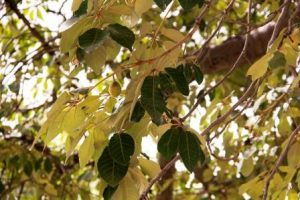
Schinziophyton rautanenii. Photo: Petra Ballings. Source: Flora of Zimbabwe
We then drove leisurely through the bush stopping often to inspect some of the 63 species of trees and shrubs, amongst which were 3 Acacia species, Baphia massaiensis, Bolusanthus speciosus, Ehretia rigida, Erythroxylum zambesiacum which is not on the Bulawayo field card. 3 Combretum, 3 Commiphora, Erythrophleum africanum, Bauhinia petersiana subsp. petersiana and Bauhinia petersiana subsp. macrantha. 4 Grewia, Kirkia acuminata, Ormocarpum trichocarpum, Schinziophyton rautanenii, Vitex mombassae, Maytenus heterophylla subsp. heterophylla and Rhigozum brevispinosum.
By 1.00 pm several people were pleading hunger, so we moved on to the farm’s hunting lodge to sit in comfortable chairs in the shade by the swimming pool for lunch. The centre of our attention became the unique brass wash hand basin in the main lodge that had come from an old Rhodesian train coach. It had to be tipped into the wall to be emptied. The recent rains had produced a thick carpet of green, green grass all around the lodge area that was difficult to leave for our afternoon adventures in Philip Palmer’s Landrover.
Driving along again, slowly, through the Kalahari sand, we found some new trees for the day. My favourite by far was the Albizia tanganyicensis with its pink bark peeling from a huge trunk. It was estimated that the largest of the several trees we saw was about 200 years old. We also saw Acacia karroo, Afzelia quanzensis, Combretum psidioides, Combretum collinum, Commiphora mossambicensis, Dovyalis caffra, Guibourtia coleosperma (not on the Byo field card), Pseudolachnostylis maprouneifolia and Rhus pyroides. Lurking in the trees were a duiker, kudu, warthogs, and many varieties of birds, all adding to our enjoyment of the outing.
As the satisfied group was happily returning to the hunting lodge, a fallen tree appeared blocking the road. It was too heavy to be moved. Our stalwart leader, Anthon, disappeared into the trees and found a passable way around the obstruction for the Landrover that saved the day. We were able to find our way back to Bulawayo by nightfall.
Many thanks to the Palmers for their hospitality. We all had a wonderful day on their farm.
-Helen Hall.
HELP! Please save your clean, used, brown paper packets. The seed bank section at the herbarium would be very happy to have them.
SHAVANHOHWE RIVER. 16 MARCH 1997.
Although many of the members present on this outing remember the Shavanhohwe River as a place for swimming and picnics in the 1960s none of us could remember exactly where these activities took place. This day however we gathered on the Mutoko road where the bridge crosses the river, returning after a brief stop some months ago with the Aloe and Cactus Society when the site looked promising for a tree Society meander. This was proved at the end of the day when a count showed that 107 species were recorded. The river was full and fast flowing, such a common and wonderful sight this year.
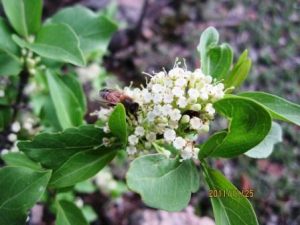
Psydrax livida. Photo: Rob Burrett. Source: Flora of Zimbabwe
Phil led the group of 28 members, and kept our attention until lunch time. It was a perfect spot for revision, and many characteristics of families were pointed out, such as the interpetiolar stipules of the Rubiaceae family, shown very clearly in the first instance by Psydrax livida. Then Vangueria infausta, Catunaregam spinosa (with thorns as the specific name implies) Hymenodictyon floribundum, Tapiphyllum velutinum, Tricalysia niamniamensis and Pavetta schumanniana. The latter genus has an added identification aide in the form of bacterial nodules in the leaf blade which can be seen when held up to the light.
The Malvaceae family was represented by the well known “snot apple’ – Azanza garckeana. When cooked the fruit of this tree produces a glutinous substance relished by some Zimbabweans.
Lannea discolor, Ozoroa insignis, and three Rhus, Rhus leptodictya, Rhus longipes, and Rhus quartiniana are all from the Anacardiaceae family; the latter, known as the River Rhus, was true to its name growing on the sandbank islands in the river. The Rhus look alike is Allophylus africanus (Sapindaceae), which often has pockets of hairs in the axils of the veins on the under surface of the leaves, and does not smell very distinctly of apple when crushed.
Another group which was well represented was Caesalpinioideae with Bauhinia petersiana, Brachystegia boehmii, Brachystegia spiciformis, Burkea africana, Cassia abbreviata, Julbernardia globiflora, Peltophorum africanum, Piliostigma thonningii, Schotia brachypetala and Senna singueana.
Some of the uncommon species on this side of the river were Olax dissitiflora, Olax obtusifolia, Markhamia zanzibarica, Friesodielsia obovata and Holarrhena pubescens (courtesy of Adrian). The beautiful Securidaca longipedunculata (violet tree) and Schrebera alata, whose compound leaves are very glossy, and the rachis winged, or as Phil aptly described them as having running boards. This makes a lovely garden tree. We were shown that Psorospermum febrifugum has stellate (branched) hairs on the underside of the leaves.
On one of the anthills Mark showed us a rarely seen creeper Solanecio angulatus whose leaves were slightly fleshy and to me looked vaguely like those of the garden weed – dandelion. Draped all over a Rhus leptodictya were very beautiful bunches of red berries of the often seen creeper Tinospora caffra (Menispermaceae).
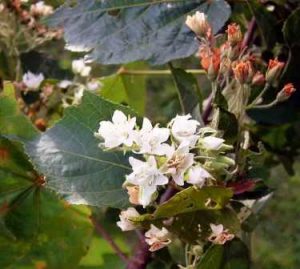
Dombeya kirkii. Photo: Rob Burrett. Source: Flora of Zimbabwe
On a remarkable anthill were, at a guess, 20 species of trees all vying for growing space. Shooting out of the top was a tree covered in white flowers, difficult to distinguish even with binoculars, and guesses of Holarrhena pubescens, Cordia africana and Dombeya kirkii were offered. We were put out of our misery when on the other side of the anthill we found another plant of the same species also in flower and within reach. Mark suggested Dombeya kirkii, and this proved to be correct when researched back at home. A surprising find – we thought it occurred at low altitudes, and the only time we have seen it ‘in the wild’ was on our trip to Bangala dam a few years ago. Also growing on this anthill was a Maerua angolensis and Mimusops zeyheri. Maerua angolensis is easy to identify because its simple, fresh green leaves have tong petioles and near the leaf blade these petioles thicken very noticeably. The fruit is also distinctive, being a long pod restricted between the seeds, hence its common name of ‘bead bean’. The flower is a beautiful semi-spherical pompom of many long anthers, the hall mark of this genus.
Some of us sought shade under the bridge for lunch, a pleasant spot with the water rushing by at our feet and the Little Swifts skimming over our heads.
A few members lazed over lunch then returned to Harare while others crossed the bridge to explore the bush on the other side of the river, ignoring the scratchily chalked warning on the back of the road sign to ‘beware of murders’. We headed for a rocky outcrop which was the home of a magnificent Sterculia quinqueloba, in flower and not at all smelly.
This side of the river proved to be quite different with three three Ochna – Ochna puberula, Ochna pulchra and Ochna schweinfurthiana. Surprisingly we saw no acacias, and only two Combretum, Combretum molle and Combretum zeyheri, and three figs – Ficus glumosa, Ficus ingens and Ficus thonningii as well as four Strychnos, Strychnos cocculoides, Strychnos innocua, Strychnos potatorum and Strychnos spinosa.
So, an interesting area even if rather degraded, and the only skull seen was that of a goat.
-Maureen Silva Jones
BOTANICAL GARDEN WALK: 1 April 1997
The subject of today’s walk was the Annonaceae or Custard-apple family. This is a family of mainly woody plants (shrubs, trees and a suffrutex) with a primitive flower structure, often in threes. The carpels are either fused (as in Annona itself) or free, and thus looking like fingers, as in, for example Friesodielsia.
The leaves are typically arranged alternately, 180 degrees apart, on either side of the branchlets. On crushing the leaves they are distinctly aromatic and some (as Meg pointed out are distinctly grey beneath). There are no stipules.
Maureen had prepared a list and this had 14 species in 9 genera. In addition, I understand, Monanthotaxis buchananii has been found in the Eastern Districts.
Firstly, the genus Xylopia was examined and the characters listed above were illustrated.
There are three species. Two are low-altitude eastern Districts species. Xylopia aethiopica occurs in forests in the Haroni-Rusitu area. The specimen in the Gardens was in flower and we were able to see its 3 sepals and its quite large whitish yellow petals occurring in 2 whorls of 3. Xylopia parviflora occurs in areas of high rainfall, but is not a proper forest species, but occurs more at the forest edge.
The other species of Xylopia, namely Xylopia odoratissima, occurs on Kalahari Sand in the north and west of Zimbabwe and Tom does not have a specimen of that in the Gardens.
On to Monanthotaxis chasei, which has fruits very like Friesodielsia, but is very readily distinguished by the markedly grey-blue underside of the leaves. It may be a shrub or sometimes a big liana. It occurs in parts of the Eastern Districts and also in the outliers such as the Nyoni Hills.
Uvaria lucida was examined next. It is superficially similar to Artabotrys monteiroae, which was growing nearby, but lacks the distinctively-shaped hooks of that species. In Uvaria, the flowers occur on normal peduncles. In passing, Tom mentioned that the other species of Uvaria, namely Uvaria gracilipes, is a very rare and delicate species occurring on basalt in the SE of Zimbabwe and there are no specimens in the Gardens.
Later we saw Artabotrys brachypetalus. This is a fairly frequent species, usually a liana by lowveld rivers, but also occasionally occurring on rocky hills especially if they are moist in winter. Both species of Artabotrys possess the hooks referred to above.
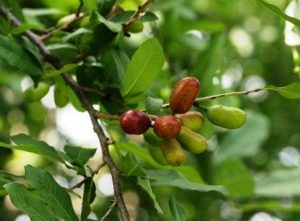
Cleistochlamys kirkii. Photo: Bart Wursten. Source: Flora of Zimbabwe
On then to Hexalobus monopetalus (Baboons Breakfast) and Friesodielsia obovata, both well known to most members and from there to Cleistochlamys kirkii, a species of the jesse, but also occurring in woodland in the lowveld.
Monodora junodii was then examined. In November, we have often seen its strange purple-black flowers, but these were not around today. The leaves are obovate and are undulate on the margins. This plant occurs on hills and is widespread in the lowveld.
Finally, the genus Annona itself. Annona senegalensis has its carpels fused to form a fruit. It is a savannah species, but occurs mainly at low altitudes. The suffrutex Annona stenophylla ssp. nana occurs commonly around Harare, but was not seen on this occasion. Lastly, in the gathering dark, we looked at some cultivate Annona and Spondias species.
All in all, a most interesting evening, which was very helpful in getting the family clearer in our minds. Our thanks to Tom once again.
-Mark Hyde
THE TALL, THE FAT AND THE ANCIENT
Continued:
THE FAT
According to the Guinness Book of Records (1996) the African Baobab, Adansonia digitata, is generally considered to be the species attaining the greatest girth, and a maximum of 43m was quoted (141 ft). This represents a considerable climb down from the 1994 edition’s claim of a girth record of 54.5m (189,8 ft), and my personal belief is that the lower figure is the more accurate.
The most massive tree on earth is the General Sherman Tree, a specimen of giant sequoia, Sequoiadendron giganteum, with a girth of 35.22m (115,55 ft) and very little taper for more than half its height of 82.91m (272 ft). Other giant sequoias are taller and have somewhat greater basal girths, but none has the sheer bulk of the General Sherman Tree.
For many years a tree in Oaxaca, Mexico, known as El Gigante, or El Arbol de Tul, a specimen of Montezuma cypress, Taxodium mucronatum, was believed to have the thickest trunk of any tree in the world (35.8m in girth), but relatively recently El Gigante has been shown to be three trees fused together. It has become a historic landmark, and as long ago as the 1520s the Spanish conquistador Hernan Cortés wrote about it. It may be that some of the very large African baobabs are, in fact, two or more trees that have become fused. Two specimens near Chiredzi, known as The Lovers, are already touching for about one metre from ground level, and will undoubtedly become fused at some time in the future.
Some strangler figs build up massive trunks through a fusion of their aerial roots. There is a large specimen of Ficus thonningii in Mutare that now has a girth of 40m round its aerial roots, which in time will appear as a solid trunk of nearly 13m in diameter, outstripping any Baobab in Zimbabwe.
The Big Tree of Chirinda Forest, Khaya anthotheca, has a basal diameter of 5.25m (16.49m in girth) measured over the buttresses, and someone once calculated that there is enough wood in this tree to floor, panel and furnish the whole of Zimbabwe House in London!
-Lyn Mullin.
TREES AND OTHER PLANTS OF DAVID LIVINGSTONE’S ZAMBEZI EXPEDITION 1858-1863
LIVINGSTONE’S BAOBAB AT SHIRAMBA
A slip of the finger in Tree Life No 206, April 1997, has Livingstone’s Baobab at Shiramba in Mozambique with an earth-shattering diameter of 67.17 metres. The correct figure should have been 7.17m. The original measurement in 1858 had a circumference of 72 feet, i.e. a diameter of 6.99m, and re-measurement in 1965 showed that the diameter had increased by 18cm to 7.17m.
Continued from Tree Life 206.
EBONY. 6 September 1858: “…and we cut down an ebony or black wood tree of about a foot in diameter. The ebony is put into water and the young white part soon rots off. This was standing in the forest and the white was rotting. The wood was of a light brown colour.”
10 April 1860. “There is abundance of ebony here” (at Sena), “very black and of good quality. It is not of the true ebony genus but one of the Papilionaceae.”
There is some uncertainty about what species Livingstone was referring to in his journal entry of 6 September 1858, but the journal for 10 April 1860 most certainly refers to Dalbergia melanoxylon the well-known African Blackwood, murwiti (Shona) or umbambangwe (Ndebele).
The true ebony is Diospyros ebenum from India and Sri Lanka.
FUSTlC. 22 June 1860 “A great deal of Fustic or Machuria of large size in these parts”. This was written during the overland march from Cabora Bassa to Victoria Falls, and the tree referred to was probably Maclura africana (Cardiogyne africana), a spiny shrub or small tree that exudes yellowish latex from the bark. The name fustic is generally applied to Chlorophora tinctorea and Maclura pomifera from tropical America and the United States, respectively.
GINGER. 14 February 1859, in Kirk’s enclosure to Dispatch no.13: “sugar cane, tobacco and ginger are grown in the gardens.” Ginger, Zingiber officinale, was noted under cultivation in the Shire Valley. This is a native of eastern India and the source of spice ginger. It has been cultivated since antiquity and was probably introduced into Central Africa by the Arabs, possibly by the Portuguese.
GUM TREES. 18 December 1862, in a letter to his daughter Agnes Livingstone: “…visiting the grave where I have again been to plant some Australian gum trees…” David Livingstone’s wife, Mary, daughter of Robert and Mary Moffat, died at Shupunga on the lower Zambezi on 27 April 1862. She was buried there and Livingstone planted some eucalyptus at the site of the grave. The species is not recorded nor do we know whether any survived.
GUNDU. 5 February 1862 in a letter to José Nunes, “Her Britannic Majesty’s Vice Consul at Quilimane”: “I want a large Gundu tree from your estate at Shupunga, the larger the better to see if it will serve for shipbuilding.”
Two possibilities suggest themselves here. The more likely of the two is Milicia excelsa, better known as Chlorophora excelsa, iroko or mvule. Among the vernacular names for the tree in Mozambique is mgundu or magundu, very close to Livingstone’s gundu. The second, but less likely, possibility is Brachystegia spiciformis, Msasa, which Livingstone would have known from his missionary days at Linyanti in present-day northern Botswana. The Ndebele name for the tree is igonde – again, close to Livingstone’s gundu. This tree possibly does occur in that general region of Mozambique but its typical form and size would make it an unlikely candidate for shipbuilding.
INDIAN HEMP. 14 February 1859, in an enclosure by Dr. John Kirk to Livingstone’s Dispatch no 13: “By the banks we observed … Indian Hemp …”
Indian Hemp is Cannabis sativa, better known in Zimbabwe as dagga or mbanje. Kirk’s observations were made in the Shire Valley.
IRONWOOD. 27 June 1863: “Started from Malango early and travelled 9 miles to deserted village, Mpimbe; a fine level path with ironwood.”
This entry was written in the Shire Valley and the tree referred to here could have been any species with a very hard wood. “Ironwood”, unfortunately, is all too common a name for it to be identifiable.
KASONGA. 1 June 1860: “Great quantities of a species of cucumber with spines, kasonga, are cultivated in order to make oil of the seeds”
2 June 1860: ” … and though like the colocynth, has no bitterness of taste. The larger kind is named Makaka.” This spiny cucumber is likely to be Cucumis metuliferus, known in Shona as mugagachiga, but it could also be Cucumis anguria, which is known in Shona as mujachacha and in Ndebele as amakaka.
LEMON. 14 February 1859, in an enclosure by Dr. Kirk to Livingstone’s Dispatch no.13 “Lemons are abundant in the forests.”
The lemon is Citrus limon, a native of eastern Asia but cultivated widely from antiquity. The lemons Kirk saw in the Shire Valley were probably introduced by Arab slavers or by the Portuguese.
LIGNUM VITAE. 5 August 1859: “Wooded at a Lignum vitae tree 16 feet 6 in. in circumference.” This translates into a diameter of 1.60 metres.
6 August 1860: “Went by southern channel to cut wood. Lignum vitae too thick for saws.”
10 April 1860 “Combretum is that which yields lignum vitae.”
In a report on the navigation of the Zambezi, Livingstone wrote, on 26 July 1859 “We have in the course of one year cut up into small pieces upwards of one hundred and fifty tons of Lignum vitae alone …”. All of this wood was cut for the purpose of firing the boilers of the expedition’s steam launch, and a very arduous task it must have been for the species he called Lignum vitae was undoubtedly Combretum imberbe, one of the hardest woods in Central and Southern Africa, with a density of 1230 kg/m3. It is no wonder Livingstone called it Lignum vitae, a name that properly belongs to a Central American tree, Guaiacum officinale, which is generally regarded as having the hardest and heaviest timber in the world at 1250 kg/m3.
The vernacular names of Combretum imberbe are (English) Leadwood; (Afrikaans) hardekool; (Shona) muchenarota, mutsviri; (Ndebele) umchenalota, umtswiIi.
MAIZE. 31 August 1858: “Mapira is the name of the large millet or sorghum and Mapira manga of maize (foreign mapira).”
14 February 1859, in an enclosure by Kirk to Livingstone’s Dispatch no. 13: “Nowhere on the Zambezi have I seen so much cultivation, maize, yams… are grown in the gardens.”
Livingstone’s observations were made in the Zambezi Valley and Kirk’s in the Shire. Maize, Zea mays, originated in northern South America and has been cultivated since antiquity. Its introduction into Africa was probably made from Brazil by the Portuguese some 400 years ago, but it is clear that the people of the Zambezi Valley were well aware of its foreign origins during Livingstone’s day.
MANGO. 1 September 1861: “…and one Mango tree was seen at our last bivouac.” This tree was seen at Lake Malombwe to the south of Lake Malawi. The mango is Mangifera indica, a native of Southeast Asia, and probably introduced to eastern Africa by Arab slavers.
MANGROVE. 10 September 1858 in Dispatch no.11: “The parts near the sea covered with mangrove are pure and excessively adhesive mud.”
This was almost certainly Bruguiera gymnorrhiza, which occurs from the Zambezi delta to the Transkei coast.
MASUKA. 28 July 1860: “All around us are mountains covered with trees like those on Zomba – Masuka and other kinds of fruit.” This was written on the overland march up the Zambezi from Cabora Bassa, about seven days from Victoria Falls. Masuka is certainly Uapaca kirkiana, the well-known mushugu or muzhanje of Mashonaland, or umhobohobo of Matabeleland, a much-favoured fruit wherever it occurs. This is one of many trees named in honour of Sir John Kirk, Livingstone’s second-¬in-command on the expedition.
LOTUS. 21 September 1861: “We are at the mouth of a stream, but it is dammed up by a bar of sand… it is deep inside and has lotus on it.” This was written during the exploration of Lake Malawi and Livingstone was undoubtedly referring, not to a species of the genus lotus (leguminous plants), but to the aquatic Nymphaea, possibly Nymphaea caerulea.
To be continued.
These anecdotes are extracted from an interesting document researched and written by Lyn Mullin.
ANDY MACNAUGHTAN CHAIRMAN


